Searching for a Lost Kami
An adventure on San'in's Mount Daisen
When you look at mountains, the first thing that probably strikes you is their beauty. Perhaps you think, what a great place to go climbing, or have a picnic, or simply take a walk through the forest. I suspect most people think this way, and so do I. But there is another way of looking at the mountains in Japan, an older way. One that isn’t rooted in leisure, but spirituality.
Mt. Daisen, at a little over 1,700 meters the highest mountain in the Chugoku region, is a perfect example of this dichotomy. Today, it’s part of the Daisen-Oki National Park. It’s a beautiful place, and easily climbable in a day; some 90,000 summit it every year. A series of paths lead to the top, with its incredible views of the Sea of Japan. One, the Natsuyama Trail, is designed for hikers. Another is a steeper ascent that follows in the literal footsteps of a trail historically used by religious pilgrims.
That’s the one I wanted to climb. When I hear things like “old trail historically used by pilgrims” my sense of curiosity starts tingling. No matter how steep or difficult (well, within the realms of my climbing abilities and common sense), I want to take that way. And Mt. Daisen’s is particularly interesting. It’s simply fun to visit. But it also captures Japan’s spiritual worldview in ways old and new.
To understand what I mean, let’s turn back the clock – way back, to before the dawn of recorded history. Understanding the Japanese heart means understanding the mountains. My nation is covered in them. Some are quite rugged and high. And before the advent of modern technology, they were seen as very dangerous places. The terrain could be confusing; the weather unpredictable; and there were hazards from wild animals to rockslides, not to mention simply slipping and falling. This made them the sort of places that ordinary folk avoided.
Perhaps because of this, mountains were viewed as places where all sorts of spiritual beings resided. Kami, the avatars of the natural world in Shinto; hotoke, the deities of Buddhism; the spirits of the dead; yokai, oni, and spooks of all sorts. This makes sense, for the normal “rules” of life didn’t apply there.
Today, Mt. Daisen is known for Jizo-shinko: the worship of the Buddhist deity known as Jizo. Japanese have long treated Jizo as a kind of guardian angel, for children in particular but everyone in general, regardless of their faith (or even if they possess no faith!) Statues of Jizo can be found nearly anywhere, small, baby-like, with gentle smiles. Locals often show their appreciation by knitting them little caps and bibs, to protect them from getting cold as they stand watch. That’s the kind of affection Jizo inspires here. And Mt. Daizen’s Jizo-shinko expanded the concept to include animals as well. A belief in the mountain’s divine power to protect their livestock attracted large numbers of farmers eager to protect their assets, which led to the establishment of a cattle-trading market at the foot of the mountain. By the end of the 19th century it grew into the largest in Japan, with more than 10,000 horse and oxen traded annually. This is the ancestral birthplace of the “wagyu” the world loves today.
Daisenji temple has been a spiritual center for 1,300 years. Today it is Buddhist, but in times of old it was the locus for a broader nationwide spiritual philosophy known as Shugendo, which fused elements of Shinto, Buddhism, Taoism, and local folk religion. Most of all, they worshipped mountains.
Practitioners were known as gyoja, “those who train.” Gyoja saw mountains as their “spiritual mandalas,” with the peaks representing the holiest of holy ground. They called Daisen’s peak Misen, from Shumisen, a sacred five-peaked mountain from Buddhist cosmology. Gyoja believed that truly expert practitioners might open and access a world beyond even Misen. This is why they subjected themselves to all of the physical and mental trials that mountains like Mt. Daisen had to offer, to bring themselves closer to the sublime.
Shugendo was a radically inclusive sort of belief system. Its holy grounds often incorporated Shinto shrines and Buddhist temples side by side. And they often worshipped deities that were fusions of Shinto kami and Buddhist deities, which they called gongen, or avatars. This was the case on Mt. Daisen as well. The local gyoja venerated an avatar that represented a fusion of Mt. Daisen, which was seen as a Shinto kami in its own right, and Jizo. They called it Daichimyo Gongen. And it anchored religious life on Mt. Daisen for more than a millennium.
The old trail I wanted to climb is called the gyoja-dani (gyoja valley) course, and it begins at Daisenji temple, deep in the forests that cover Mt. Daisen’s foothills. It is a remnant of the era when this was once a Shugendo mountain. You may have noticed that I have been using the past tense a lot here. That is because Mt. Daisen isn’t a Shugendo mountain anymore, and there is no sign of Daichimyo Gongen, either. The reasons for that can be traced back to one of the biggest surprises in Japanese history: the sudden arrival of American gunboats in Japanese waters in 1853.
In the decades to come, all sorts of foreign influences flooded into the country. Western technologies and philosophies caused major changes in the way we governed ourselves and lived our lives. They compelled us to question the ways we had long thought, fought, and created. And our spiritual traditions were no exception. The government feared that Western philosophies might overwhelm our culture as we Westernized. And so in 1868 they took the dramatic step of reorganizing the Japanese religious landscape. Buddhism and Shinto would be forcibly separated, so that the authorities could remodel the latter into a state religion. But Shugendo was considered too thoroughly fused to untangle. It was banned outright, in a prohibition that would last until after Japan’s defeat in World War II.
It has been a hundred and fifty years since Daichimyo Gongen disappeared from Mt. Daisen, along with other avatars of Shugendo across the land. I wanted to climb the gyoja-dani course to see if I could still feel what the gyoja did, to sense what they sensed. We can’t see the kami and hotoke with our own eyes. So can a god really disappear? I didn’t think so. But I needed to find out.
My search for a lost kami began early on a misty late-spring morning. When my husband Matt and I set out from our inn, dew still clung to the rapidly greening foliage, and clouds to the peaks of Mt. Daisen far above. But even from these earliest moments the mountain made its spiritual heritage obvious. The trail began at a Buddhist temple. But almost immediately, we had to pass through a large stone gate – a tori’i, symbol of Shinto.
This isn’t an altogether uncommon thing in Japan, where the lines between faiths aren’t nearly as firm, or fraught, as those abroad. But it tells a story, for those who knew how to read it. Beyond the gate presented sacred territory, a place where the Shinto kami and Buddhist hotoke and all of the other countless spirits of Japanese belief have dwelled together in quiet harmony for a very long time. It was very easy to imagine this having been a place where Shugendo gyoja trained long ago – an impression reinforced all the more when, just beyond the Shinto gate, we found a cluster of Buddhist statuary. Japan’s patchwork of spiritual traditions, woven into a mountainside in wood and stone.
I entered the grove of statues. The smell of loam filled the air with every footstep, and I almost had to duck beneath a moss-covered tree-trunk that bisected the space at a diagonal. One of the largest was a Fudo Myo’o, a fierce-looking Buddhist deity associated with Shugendo. The others were all Jizo. The statues were quite weathered, covered in moss, their features softened by long exposure to the elements. It was obvious I was in their realm now, an older one. I pressed my palms together, Buddhist style, in a greeting and sign of respect and continued on. We had many hours walk ahead if we were to reach Misen.
The path itself is unique: constructed from countless natural stones, worn smooth by the feet of countless visitors over countless years. Shortly we came across a creek bisecting the path: another symbol. In Japanese spiritual lore, water separates the land of humans from the great beyond of the kami and hotoke, between life and afterlife. A low stone bridge, carved with Buddhist sutras, arced over the creek. We crossed it and continued beyond.
I found another old Jizo statue on the side of the path, leading to a Shinto shrine. This one was carved into a boulder, centuries ago, as an offering from a wealthy merchant. The effigy has been watching over the path ever since.
At the end of the bumpy stone path, we found a formidable stone staircase. Atop it sat a grand-looking Shinto shrine. Its name, I knew, was Ogamiyma Jinja – “great kami-mountain shrine.”
But I also knew this shrine hadn’t always been called that. Long ago, it had a different name: Daichimyo Gongen Jinja.
This is where an effigy of the lost avatar I sought had been enshrined, until that Meiji-era order to separate kami from hotoke, Shinto from Buddhism. Daisenji had no choice but to comply, and in 1875, after some 1,300 years of veneration, they removed Daichimyo Gongen and enshrined a new Shinto deity called Onamuchi-no-kami. Daichimyo Gongen Jinja became Ogamiyama Jinja, and a site of Shugendo worship became a Shinto one. Which it remains today.
Yet there were subtle clues here, if you looked with the right eyes. The kami may have been new: 150 years was a blink in the history of my nation’s spirituality. But that massive wooden structure, the shrine itself, was anything but. The massive timbers used to build it spoke to its age, hewn from old-growth forests of the sort that are sadly rare today. But the biggest hint of all was hiding in plain sight: the gorgeously gabled roof. I knew from my studies that this style was known as gongen-zukuri. Gongen! Like the avatar. This was a popular design long ago, when Shinto buildings often incorporated Buddhist architecture. A fusion of two faiths’ symbols, once used to house an avatar that was a fusion of two faiths. How perfect was that! This building is in fact the largest surviving gongen-zukuri shrine in Japan. It’s a testament to how Daisen Shugendo once flourished here.
In fact, archaeological excavations have revealed the remains of at least 170 buildings that once made up a huge “campus” affiliated with Daisenji. At its peak, some 3,000 monks lived here, many of them trained as warriors to guard the mountain during the tumultuous Warring States period. They must have been strong, for it was they who laid the path of rocks leading here, one of the longest stone paths of its sort in Japan. Those warrior monks are gone, long since laid to rest in graves scattered around the mountain. And Daisenji’s buildings have been reduced to just fourteen. But the path remains. I think they’d be proud to know that.
The entrance to Daisen’s mountain-climbing trail lay just beyond the shrine. Here the stone path ended, and a long dirt trail began. In times of old, only a chosen few, just five of Daisenji’s top gyoja, were allowed to tread this path. Today, of course, it’s open to anyone who wants to climb. And climb we did.
Locals sometimes call Mount Daisen “Izumo Fuji,” for from certain angles, the west in particular, its smooth slopes resemble those of the iconic mountain of my country. I recall once catching sight of it from a car window, years back, and doing a double-take.
But from the north, Mount Daisen presents a totally different face. About a half hour’s hike from the shrine, we came to a valley, wide and open, filled with rocks. This was gyoja dani - the valley of the Shugendo practitioners who used this mountain as a spiritual training ground. From this angle, Mount Daisen doesn’t resemble Fuji at all. It is an awe-inspiring string of peaks filling my vision entirely. We stand for a while in the morning light, drinking it all in. By now the clouds had cleared a bit, revealing snow in the craggy face of the range ahead. Occasionally we heard rumbles as rocks tumbled down the steep slopes. Looking more closely, we could see many of the crevices filled up with huge piles of stones, evidence of centuries and millennia of rockfalls. This is a beautiful place, but also a dangerous one, home to powerful forces ungoverned by human rules. It must have taken a lot of bravery to enter these hills without modern trails or gear. It’s easy to understand why the gyoja, followers of that lost avatar, came here to pray. Simply being here feels like a prayer.
It took us roughly three hours to reach the top. Three hours up what seemed an endless flight of rough stairs. At one point we encountered a snowfield, too large to avoid. We’d purchased sets of microspikes for this very occasion, strapped them onto our boots, and carefully crunched our way higher through the icy terrain. The winds grew cooler and cooler as we ascended. We watched the clouds nervously. They were back, and looked like they might bring rain. I hoped they might break enough for us to get a view from the top.
Alas, Misen was what hikers call “socked in,” shrouded in thick fog. Wrapped in that blanket of cloud, I sat for a while and thought about Shugendo practitioners in old times. Shugendo literally means the “way of acquiring power.” Gyoja trained themselves in the mountains to gain power, which to them meant the ability to make contact with spiritual beings in realms beyond our own. Surrounded by mists that broke only occasionally to reveal snatches of Earth far below, I wondered if I might have found it myself.
We took the same path back down. When we finally returned to the shrine, I made a point of going inside, where I bowed twice, clapped twice, and bowed once again, in Shinto style. I wanted to thank the mountain for letting us in, and allowing us to return unscathed. But I also took the opportunity to peer deeper into the prayer hall, to the altar beyond. It was empty, just like the altars of most Shinto shrines. For the kami are invisible; they are, as a priest once told me, “the space in your heart,” to feel all of things that make life worth living. If you think they’re somewhere, then they are.
So Daichimyo Gongen isn’t here, anymore. But neither is he not-here, if you get my meaning. This shrine venerates a Shinto deity called Onamuchi-no-kami, but if you ask me, this “newcomer” and the Avatar of old are one and the same. Both symbolize the mountain itself. And that hasn’t changed one bit. Names are just names. What is important is our feelings – our awe at the stunning beauty of this place, our respect for the unpredictable powers of nature. Daisen literally means “great mountain,” and in the end, that’s all that matters. No matter what we call it, it will always be here for us.
I wrote a book about my experiences and adventures exploring Japan’s spirituality. It’s called Eight Million Ways to Happiness, and is due out in December of 2025. You can pre-order it here!



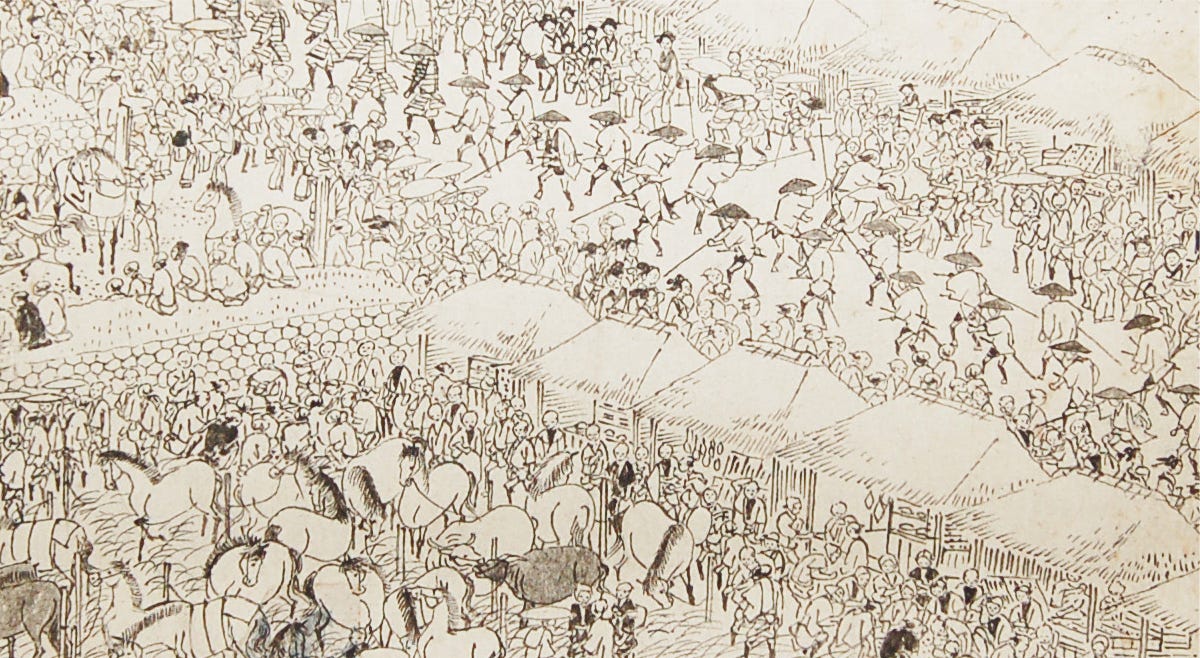

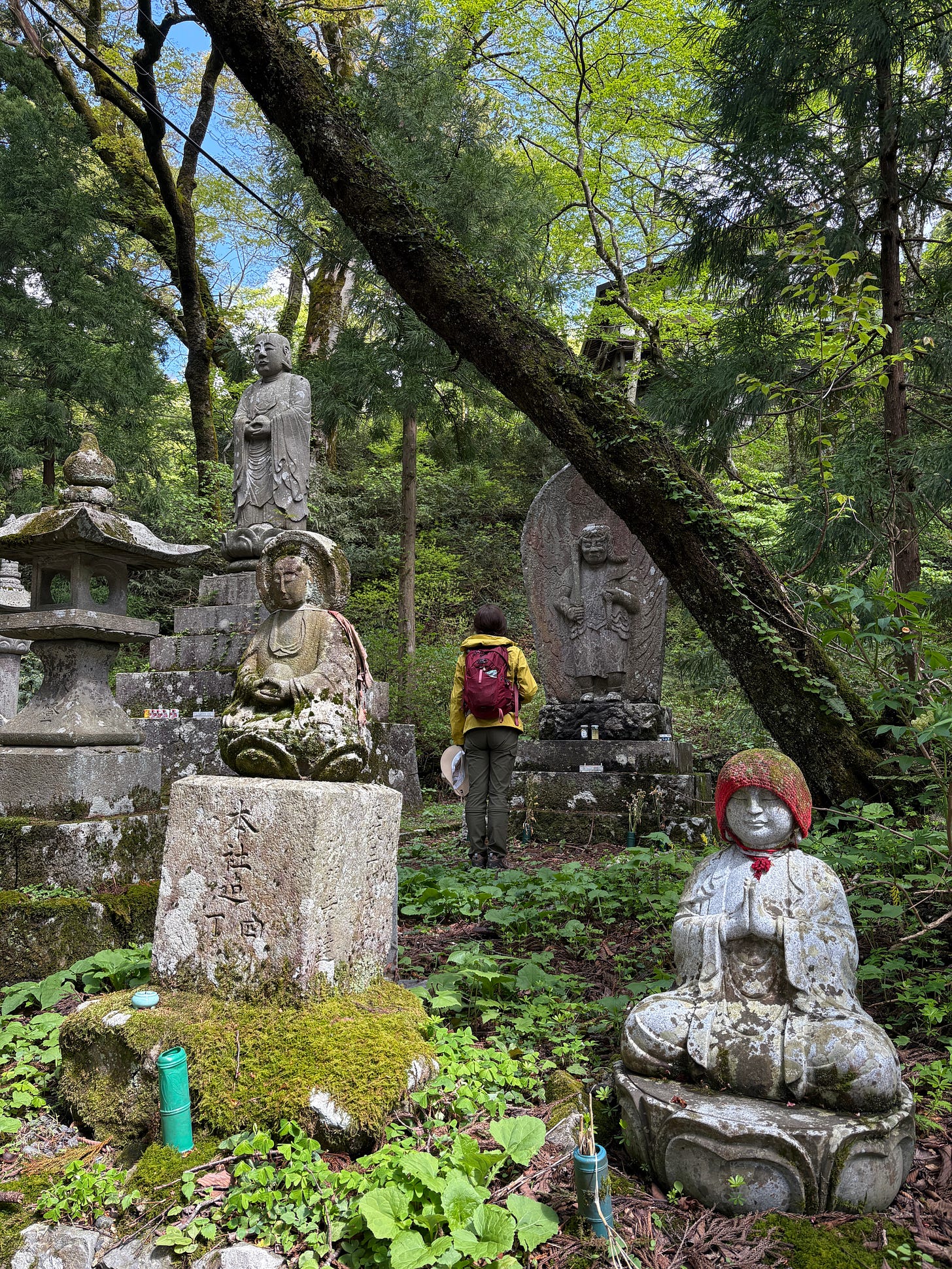




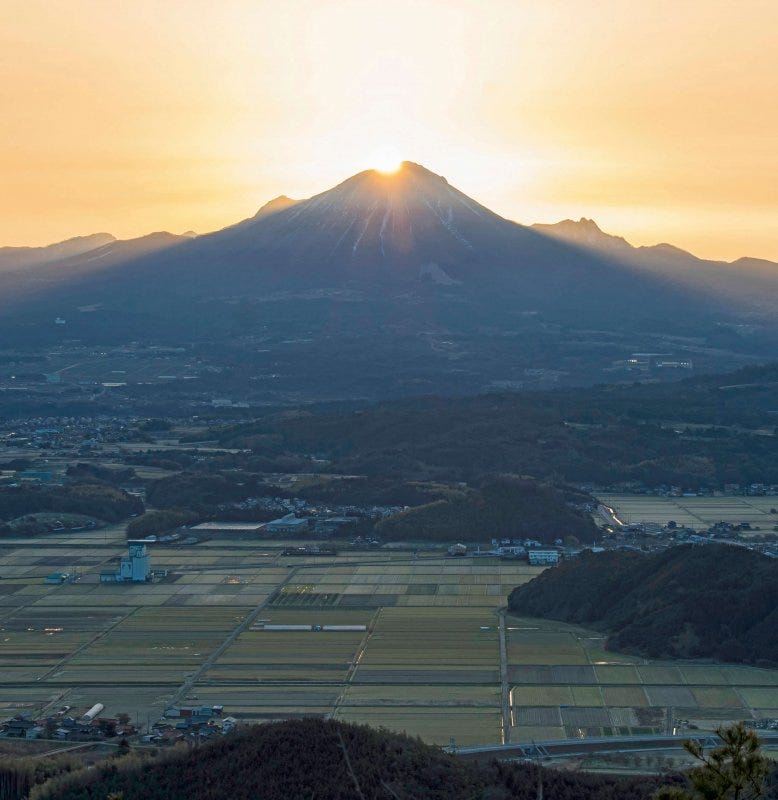
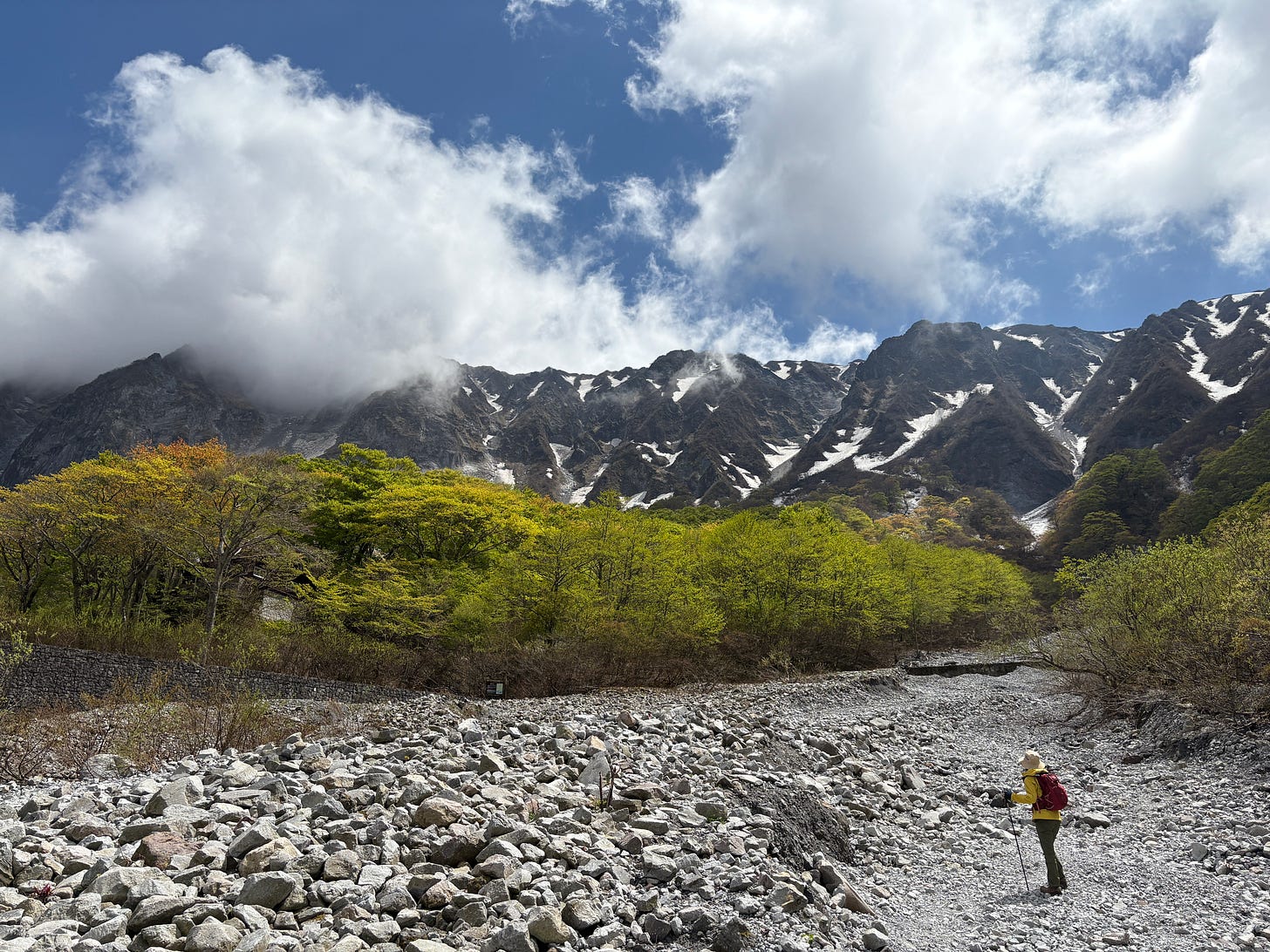
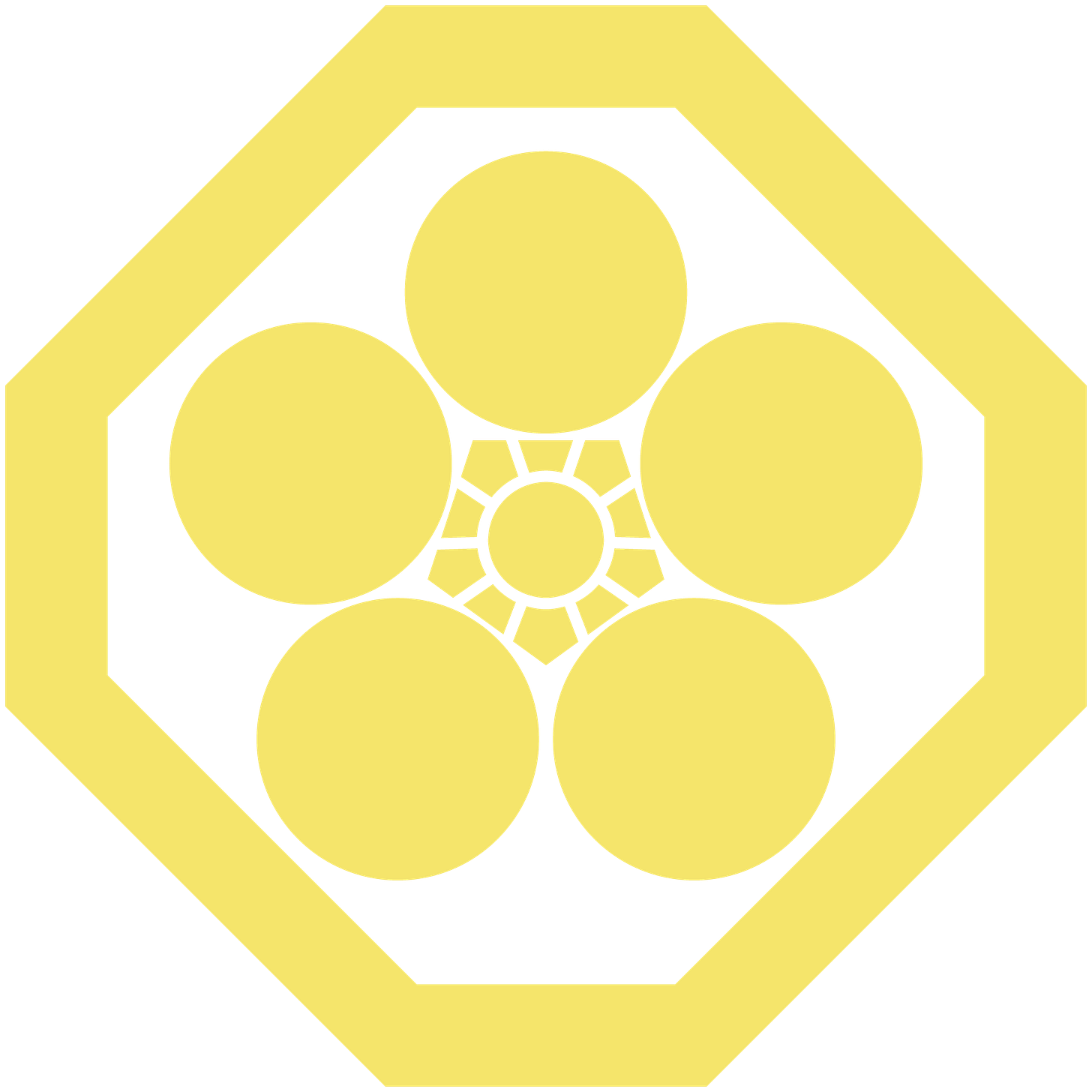

Thank you for writing about one of my favorite mountains in Japan. Mount Daisen has such majesty and beauty. Unfortunately, I have never hiked there. But I have had picnics on Daisen's slopes. undoubtedly, the best picnics in my life.
I almost couldn't believe that you were writing about Daisen - Izumo-no-Fuji when seen from the northern Izumo part of Shimane-ken - in fact the perfect cone shape was viewed directly from my staff-room when I spent two years at Matsue-Shōgyō (Commercial) High 1991 & 1992. Or from southwestern Tottori-ken - Hōki-no-Fuji. The drive up to the town on Daisen - tall trees either side - there was something of north-western US appearance to my mind's eye - leading just east from Seattle towards Snoqualmie Falls? Anyway - in the springtime Daisen - new green leaves, yama-zakura - snow wrapped around tree trunks - or - as in the photos you posted - sliding down the steep valleys from those peaks. Or in the summer reaching above the humidity - or the golds and bronzes and crimsons of the autumn - always beautiful. I've not climbed to the top - to Misen - though friends regularly did so - and a Buddhist priest friend from nearby Hōfu declared that it had given him purpose when returning dejected and depressed from his priestly studies - on the verge of giving up. He decided to climb to the top - found his purpose - and when I met him 30+ years later - gave me one of his paintings of Daisen - his daily ritual was to begin the day with a watercolour painting of Daisen. I have it still. This was just weeks before I walked the 88-temple pilgrimage around Shikoku - and he gave me a juzu made from the seeds of the banyan tree beneath which Buddha achieved his enlightenment or satori. Which he had just brought back from India on one of his regular visits. In meeting him other uncanny connections came to light. I was walking the 88 because many years earlier I had joined a Rinzai sect Priest (and high school Principal) his wife - an English teacher colleague of mine - and their youngest son - of three - Tatsushi - then 12 - just in his first weeks of middle school - on a local Izumo section of a fuda-uchi pilgrimage - in honour of my colleague's mother not long passed away. Years later the son was adopted by his father's aunt and husband - a Shingon Priest - no sons, a daughter married to a businessman in Ōsaka - no one to take over the temple - Mine-ji (in Unnan-shi in Shimane-ken). Tatsushi went to add to his Rinzai studies to - in some senses - come up to speed on Shingon rituals with the man I had met near Hōfu - and who later officiated at Tatsushi's wedding. And changing his name to Matsuura Kaihen. But before that my wife and I had attended his ritual severance from his father's Rinzai sect temple - to the welcome ceremony and celebrations of his new Shingen temple life (a temple dating back to the 7th-century). Everything quite fantastic - yama-bushi in attendance, fire ceremonies etc., etc. Kaihen had walked the 88-temples and inspired me to do the same - and it was to Mine-ji that I went upon completing the 88-temples - and left there my hat and my staff and my banyan tree juzu! As I followed your path I realised that I have visited that upper level Shrine as well as Daisen-ji, lower down. But I have never read a description as lyrical or as fully explained as this entry here. Thank you very much. I will buy your book - of course - when it is published! Jim